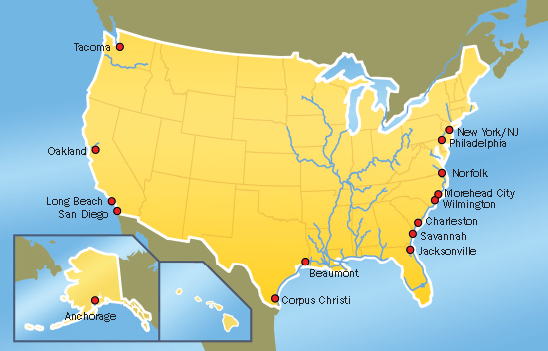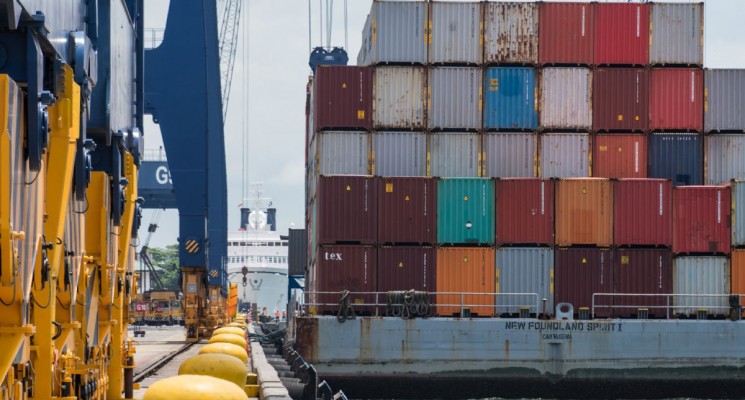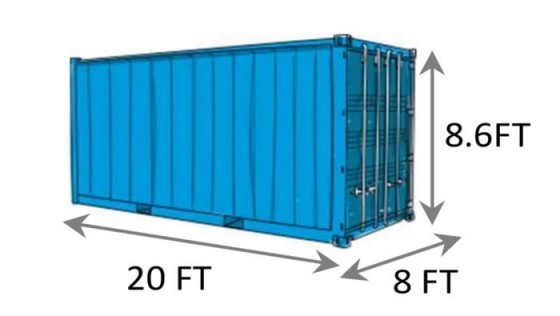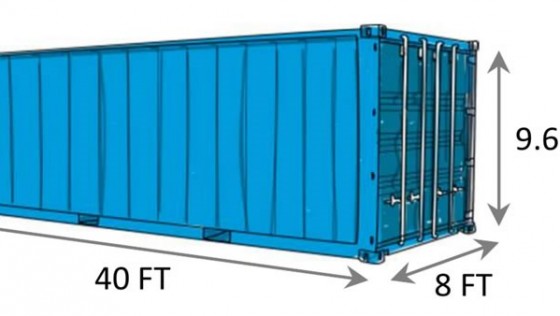Understanding Container Shipping to Europe from the USA
Container shipping to Europe from the USA is crucial in international trade, connecting businesses and consumers across the Atlantic. Every year, millions of tons of goods are transported in standardized containers from American ports to various European destinations. This complex process involves numerous stakeholders, regulations, and logistical challenges.
Whether you’re a business owner looking to expand into European markets or an individual planning an overseas move, understanding the ins and outs of container shipping to Europe is essential. This comprehensive guide will walk you through the key aspects of shipping containers from the USA to Europe, including:
- Selecting the right shipping method for your needs
- Navigating popular ports in both regions
- Understanding container types and sizes
- Managing costs and regulations
- Choosing a reliable freight forwarder
By the end of this article, you’ll have the knowledge to make informed decisions about your shipping needs, ensuring a smooth process for container shipping to Europe.
MAJOR CONTAINER SHIPPING PORTS IN THE USA AND EUROPE :
The major shipping ports in the USA and Europe are;
USA Ports:
- Los Angeles
- Long Beach
- Port Elizabeth Newark, NJ
- New York
- Savannah
- Houston
- Seattle
- Norfolk
- Tacoma
- Charleston
- Oakland
- Miami
- Port Everglades
- Philadelphia
- Baltimore
- New Orleans
- Jacksonville
- Wilmington, NC
- Boston
- West Palm Beach
- Chester
- Gulfport
- San Diego
- Tampa
- Freeport
- Everett

Europe Ports:
The most popular container shipping ports in Europe are;
- Vlora, Durrës (Albania)
- Vienna, Linz (Austria)
- Ghent, Liege (Belgium)
- Burgas, Varna (Bulgaria)
- Split, Rijeka, Ploče, Vukovar, Osijek and Zadar, (Croatia)
- Limassol, Larnaca (Cyprus)
- Copenhagen, Esbjerg, and Aarhus (Denmark)
- Tallinn (Estonia)
- Helsinki (Finland)
- Brest, Bordeaux, Dieppe, Le Havre, Cherbourg, Lorient, Toulon, St, Nazaire, Lyon, Paris, Marseille, Strasbourg (France)
- Hamburg, Duisburg, Wilhelmshaven, Cologne, Essen, Frankfurt, Heidelberg, Kiel, Mannheim, Regensburg and Bremerhaven (Germany)
- Thessaloniki, Rafina, Patras, Lavrio, Katakolon, Souda, Volos, Rhodes, Katakolon, Corfu (Greece)
- Budapest (Hungary)
- Reykjavik (Iceland)
- Dublin, Shannon, Foynes, Waterford, Cork (Ireland)
- Gioia Tauro, Genoa, La Spenzia, Bari, Cagliari, Rome, Civitavecchia, Ravenna, Venezia and Livorno (Italy)
- Klaipeda (Lithuania)
- Riga (Latvia)
- Grand Harbour (Malta)
- Kristiansand, Narvik, Oslo, Trondheim, Stavanger and Tromsø (Norway)
- Gdynia, Szczecin, Swinoujscie, Kolobrzeg and Gdańsk (Poland)
- Lisbon, Porto and Sines (Portugal)
- Mangalia, Tulcea, Galati, Braila, Midia and Sulina (Romania)
- St. Petersburg, Vladivostok, Kaliningrad, Murmansk, Moscow (Russia)
- Belgrade (Serbia)
- Koper (Slovenia)
- Malaga, Gijon, Cadiz, Bilbao, Rota, Castellón, Barcelona, Valencia, Huelva, Melilla, Motril, Rota, Algeciras, Vigo, Seville, Santander, Almeria (Spain)
- Istanbul, Tusucu, Filyos, Güllük, Haydarpaşa, Izmir, Mersin (Turkey)
- Odessa, Yalta, Chornomorsk, Mariupol (Ukraine)
- Bristol, Belfast, Cardiff, Edinburgh, Hull, Newcastle, Manchester, London, Thames, Liverpool, Foyle port, Teesside, Glasgow and Southampton, (United Kingdom)

Cheapest way of Shipping From USA to Europe
Shipping costs can quickly add up, especially when transporting goods across the Atlantic. However, with careful planning and strategic choices, you can significantly reduce expenses. Here are several practical tips to help you save money when shipping from the USA to Europe:
1. Choose the Right Shipping Method
Selecting the appropriate shipping method is crucial to optimizing costs. If you have enough cargo to fill an entire container, a Full Container Load (FCL) is typically more cost-effective. FCL offers better rates per unit volume, as you’re not sharing space with other shippers, which can reduce handling fees and potential delays.
For smaller shipments, Less Than Container Load (LCL) might be more suitable. With LCL, you share container space with other shipments, allowing you to pay only for the space your cargo occupies. However, be aware that LCL can involve additional handling and potential delays, so balance the cost savings against the need for timely delivery.
If you are shipping a car fom USA to Europe or heavy equipments, Roll-on/Roll-off (RoRo) shipping offers a cost effective solution. Shipping directly onto a vessel, minimizes handling and lowers the costs.
Example: A small business in Miami shipping a few pallets of goods to Paris might save 30% by choosing LCL over FCL, while a larger shipment could benefit from FCL’s lower per-unit cost.
2. Select the Appropriate Container Size
The size of the container you choose can significantly impact your shipping costs. Overestimating your needs may lead to paying for unused space, while underestimating could result in having to book additional containers.
- A 20-foot container offers around 1,172 cubic feet of space, which is ideal for smaller shipments.
- A 40-foot container provides approximately 2,384 cubic feet and is better suited for larger shipments.
- Specialized Containers: Consider refrigerated containers for perishable goods, open-top containers for oversized items, and other options based on your cargo’s needs.
Carefully assess your cargo volume and choose a container size that closely matches your needs to avoid unnecessary expenses.
Example: A company shipping furniture from Los Angeles to Hamburg may opt for a 20-foot container instead of a 40-foot container, saving up to $500 on unused space.
3. Time Your Shipment Wisely
Shipping rates fluctuate throughout the year, with peak seasons generally leading to higher costs. To save money, consider scheduling your shipments during off-peak periods when demand is lower.
- Off-peak months: January to March are typically less busy, offering lower rates.
- Avoid peak seasons: The period from August to October, leading up to the holiday season, often sees a spike in shipping costs.
Planning your shipments around these cycles can result in significant savings.
Example: By scheduling a shipment in February rather than September, a business could reduce shipping costs by up to 20%.
4. Compare Freight Forwarders
Not all freight forwarders offer the same rates or services. It’s essential to obtain quotes from multiple providers to ensure you’re getting the best deal. Look beyond just the price—consider the company’s reputation, transit times, and additional services like customs clearance.
Tip: Use tools like an instant shipping calculator to get a quick estimate of shipping costs to various European destinations, then compare these with quotes from different freight forwarders.
Example: A comparison of three freight forwarders for a shipment from New York to Rotterdam might reveal a price difference of up to $700, depending on the services offered and the shipping route.
5. Optimize Your Packaging
Efficient packaging can help maximize space utilization, reducing the number of containers needed and, consequently, your shipping costs. Use packing materials that protect your goods while minimizing excess weight and volume.
Tip: Consider custom packaging solutions tailored to your specific cargo to make the most of your container space.
Example: By re-packing goods into custom-sized boxes, a company could fit an additional 10% of products into a single container, reducing the need for extra containers and saving on shipping costs.
6. Consider Alternative Ports
Shipping through major ports like New York or Los Angeles might seem convenient, but these ports often have higher rates due to demand and congestion. Exploring alternative ports can lead to lower shipping costs and even faster transit times.
- USA Alternatives: Ports like Savannah, GA, or Houston, TX, often offer competitive rates and shorter waiting times.
- Europe Alternatives: Consider using less congested ports like Antwerp in Belgium or Gdańsk in Poland, which might offer better rates than the larger ports.
Also, factor in the distance and transportation costs to reach different ports.
Example: A shipment routed through the Port of Savannah instead of New York could save a business up to 15% on shipping costs, thanks to lower port fees and reduced congestion.
By implementing these strategies, you can effectively manage and reduce your shipping costs, ensuring a more economical and efficient process when shipping from the USA to Europe.
NB; For fast and affordable quotes, get in touch with Ameritrans Freight International on phone +1(800)-413-2452 and email anthony@ameritransfreight.com.

Stress-Free Container Shipping to Europe:
To ensure a hassle-free container shipping to Europe, select a freight forwarder that provides accurate information and excellent customer service. A reliable company will handle customs clearance and taxation, ensuring your cargo is well protected and safely delivered. Understanding the container type and size to use for your cargo also plays a crucial role when shipping to Europe from USA.
At Ameritrans Freight International, we offer reliable and affordable ocean freight services when shipping container from Europe to USA. Whether you’re moving household goods, commercial products, or personal effects, we provide transparent pricing and the highest quality service. Get a quote today and discover how easy it is to ship with Ameritrans Freight.
Understanding container types and sizes when shipping to Europe from USA
Choosing the right container size is crucial for efficient and cost-effective shipping. The two primary container types for international shipping are:
-
Full Container Load (FCL):
This option involves exclusive use of a container for your cargo. Standard FCL sizes include:
- 20-foot containers: Offering approximately 1,172 cubic feet of space. 40-foot containers: Providing around 2,384 cubic feet of space.
FCL is ideal for larger shipments or when you need exclusive use of a container. For instance, if you’re moving household goods from New York to London, a 40ft container might be the perfect choice. On the other hand, businesses exporting products like clothing or processed foods from Los Angeles to Hamburg might opt for a 20ft container if their volume doesn’t warrant a larger size.
-
Less Than Container Load (LCL):
Ideal for smaller shipments, LCL involves sharing a container with other shippers’ cargo. LCL shipping offers a cost-effective solution for smaller shipments. With LCL, you only pay for the space your goods occupy within a shared container. This option is particularly useful for individuals or businesses shipping a few boxes or pallets from the USA to Europe. For example, a small e-commerce business in Miami sending products to distributors in Paris might find LCL the most economical choice.
The optimal container size depends on your cargo volume and weight. Carefully assessing these factors will help you select the most suitable option and avoid unnecessary costs associated with underutilized or oversized containers.
This table provides an overview of the most common container types used for shipping from the USA to Europe. When choosing a container, consider not just the volume of your cargo, but also its nature and any special requirements.
| Container Type | Dimensions (L x W x H) | Capacity | Typical Cost Range* | Suitable For | Best For |
|---|---|---|---|---|---|
| 20-foot Standard | 20′ x 8′ x 8’6″ | 33.2 m³ (1,172 ft³) | $1,500 – $3,000 | General cargo, heavy goods | Small to medium shipments, dense cargo |
| 40-foot Standard | 40′ x 8′ x 8’6″ | 67.7 m³ (2,389 ft³) | $2,500 – $5,000 | General cargo, large volumes | Large shipments, bulky items |
| 40-foot High Cube | 40′ x 8′ x 9’6″ | 76.3 m³ (2,694 ft³) | $3,000 – $5,500 | Tall or voluminous cargo | High-volume, low-density goods |
| 20-foot Refrigerated | 20′ x 8′ x 8’6″ | 28.3 m³ (999 ft³) | $3,000 – $6,000 | Temperature-sensitive goods | Perishables, pharmaceuticals |
| 40-foot Refrigerated | 40′ x 8′ x 8’6″ | 59.3 m³ (2,094 ft³) | $5,000 – $9,000 | Large volume of cold cargo | Bulk perishables, long transits |
| Flat Rack | 40′ x 8′ (No sides/top) | Varies | $3,500 – $7,000 | Oversized cargo | Machinery, vehicles, boats |
| Open Top | 40′ x 8′ x 8’6″ (No roof) | 66.7 m³ (2,355 ft³) | $3,000 – $6,000 | Tall or awkward cargo | Cargo loaded from top |
It’s important to note that the costs provided are estimates and can fluctuate based on various factors. Always consult with your freight forwarder for the most up-to-date pricing and to determine the best container type for your specific needs.


How much is container shipping to Europe from the USA?
The cost of container shipping to europe from USA depends on various factors. These factors include;
- Container size and type: 20-foot and 40-foot containers have different rates. Specialized containers like refrigerated or open-top containers will also affect the price.
- Shipping route and destination port: Ports with higher demand or longer distances generally have higher rates.
- Cargo weight and volume: Heavier and bulkier cargo often incurs additional charges.
- Time of year: Shipping during peak seasons can result in higher rates.
- Type of cargo: Certain types of cargo may require special handling or documentation, impacting the cost.
A 20-foot container from New York to Rotterdam can range from $1,500 to $2,500, depending on the time of year and the type of cargo. Shipping heavier machinery may incur additional costs of $200-$400 due to the weight surcharge.
Using a shipping calculator can help you get the accurate shipping rates to various destination ports in Europe, based on current market conditions.
Navigating Customs and Regulations for Container Shipping to Europe from USA
When shipping goods internationally, especially from the USA to Europe, navigating customs and regulations is a critical aspect that can impact both cost and delivery timelines. Properly managing this process ensures that your shipment moves smoothly through borders without unexpected delays or fines. Here’s what you need to know:
1. Understand the Customs Clearance Process
Customs clearance is a mandatory process where your goods are inspected and documented as they enter a foreign country. This process involves submitting necessary documentation and ensuring compliance with the destination country’s import regulations.
Key Documents:
- Commercial Invoice: A detailed list of the goods being shipped, including their value, quantity, and description.
- Bill of Lading (BOL): A document issued by the carrier to acknowledge receipt of the cargo.
- Packing List: An itemized list of the contents within the shipment, including weight and dimensions.
- Certificate of Origin: A document certifying the country where the goods were manufactured, often required to determine applicable tariffs or trade agreements.
- Import Licenses (if applicable): Some goods may require special permits or licenses before they can be imported.
Example: If you’re shipping electronic goods from New York to Frankfurt, ensuring that you have the correct Commercial Invoice and Certificate of Origin can prevent delays and fines at German customs.
2. Comply with Import Duties and Taxes
Each European country has its own set of import duties and taxes, which are based on the value of the goods and their classification under the Harmonized System (HS) codes. Understanding these costs upfront will help you accurately budget for your shipment.
- Value Added Tax (VAT): VAT is applied on the total value of the imported goods and varies between countries (e.g., 19% in Germany, 20% in France).
- Customs Duties: These are tariffs imposed on imported goods, which can vary depending on the product type and origin. The rate is determined based on the HS code classification.
Tip: Use an online customs duty calculator to estimate the import costs for your goods before shipping.
Example: A shipment of textiles from Los Angeles to Paris may be subject to a 12% customs duty and a 20% VAT, significantly impacting the total cost. Planning for these charges in advance helps avoid unexpected expenses.
3. Know the Import Restrictions and Prohibited Items
Each country has its own regulations regarding what can and cannot be imported. It’s crucial to be aware of these restrictions to avoid penalties, confiscation of goods, or even legal issues.
- Restricted Items: Some goods may be subject to import restrictions, such as certain types of food, electronics, or hazardous materials. These items may require special permits or certifications.
- Prohibited Items: Goods such as counterfeit products, certain chemicals, and specific types of weapons are outright prohibited in many European countries.
Example: Shipping pharmaceuticals from Miami to Amsterdam may require you to obtain specific licenses, while items like certain pesticides may be prohibited entirely.
4. Utilize Trade Agreements to Reduce Costs
The USA has various trade agreements with European countries that can reduce or eliminate certain tariffs and duties. Familiarizing yourself with these agreements can lead to significant cost savings.
- US-EU Trade Agreement: While there is no comprehensive free trade agreement between the US and the EU, various bilateral agreements can lower tariffs on specific goods.
- Generalized System of Preferences (GSP): Some European countries extend preferential tariff treatment to goods from the USA under the GSP.
Example: A business exporting machinery from Houston to Warsaw may benefit from reduced tariffs under specific trade agreements, lowering the overall shipping cost.
5. Work with a Knowledgeable Freight Forwarder
Navigating customs and regulations can be complex, especially for businesses new to international shipping. Working with a knowledgeable freight forwarder who understands both US and European regulations can simplify the process and ensure compliance.
Tip: Choose a freight forwarder with a proven track record in handling shipments to Europe, as they can provide valuable guidance and avoid common pitfalls.
Example: Ameritrans Freight International offers expertise in European customs regulations, helping businesses avoid costly delays and ensuring that all necessary documentation is accurately prepared and submitted.
By thoroughly understanding and preparing for customs and regulatory requirements, you can avoid unexpected delays, reduce costs, and ensure a smooth shipping process when transporting goods from the USA to Europe.

